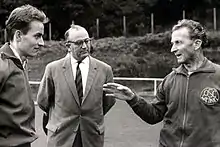Ernst van Aaken
Ernst van Aaken (16 May 1910, in Emmerich – 2 April 1984, in Schwalmtal-Waldniel) was a German sports physician and athletics trainer. Van Aaken became known as the "Running Doctor" and was the founder of the training method called the Waldnieler Dauerlauf (German: "Waldniel endurance run"). He is generally recognized as the founder of the long slow distance method of endurance training.[1][2]
Ernst van Aaken | |
|---|---|
 |
As a sports physician, trainer and advocate of new developments he directed himself fanatically to distance running and the training of "pure endurance" ("reine Ausdauer") with high mileage in the training program. He was an opponent of the method of interval training that prevailed until halfway the sixties. In the early 1960s, van Aaken trained among others the German athlete Harald Norpoth, who won silver in the 1964 Olympic Games in Tokyo on the 5000 meters. In 1972 Van Aaken was hit by a car during his own training, which cost him both legs. Since this accident he moved in a wheelchair and became also a champion for disabled sports and wheelchair racing. He also held countless lectures, also in the United States and Japan, and organized running races, especially marathons for women, besides ultra running events.
Health and longevity
Van Aaken stated that human beings were able to reach the age of 100, if they would not live so "hopelessly unbiologically". In the "biologic" life style that he advocated, sports played an important role, especially the development of endurance. He lauded a daily endurance run for everybody, also for women, elders and children, combined with moderate eating and drinking. He also held the opinion that the female sex would eventually perform better in endurance events than the male, if all social barriers were dealt with that currently enhinder this. To propagate his ideas, he wrote a number of books, the most famous titled Programmiert für 100 Lebensjahre ("Programmed for lifespan 100").
Proponent of women's running
Van Aaken was an early proponent of women's running.[3]
In 1967, van Aaken asked Anni Pede, a 27-year-old middle-distance runner and mother of two also from West Germany, and Monika Boers, a 19-year-old from the Netherlands, to participate in a marathon organized by his running club in Waldniel.[4][nb 1] According to German sports historian Karl Lennartz, journalists skeptical of 13-year-old Maureen Wilton's recent world best in Toronto, Ontario, Canada asked van Aaken if women and teenagers were capable of such a performance.[4] Mocked and derided for claiming that faster times were indeed possible, van Aaken chose Pede and Boers to prove himself correct.[4] Although the German Athletic Association (Deutscher Leichtathletik-Verband) did not yet officially permit women to run, race officials did allow the two women to start 30 meters behind the men.[4] Pede came in third, her 3:07:26.2 set a new world best, and Boers finished in 3:19:36.3.[4]
Van Aaken had tested this before in women's cross country races which had no distance limit for women. He had all the support of the regional track & field association of which he was the women's spokesman which facilitated his tasks to further women's athletics[9][10][nb 2]
See also
Notes
References
- Morris, Alfred F. 1984. Sports medicine: prevention of athletic injuries. University of Michigan; ISBN 0-697-00087-7.
- Anderson, Bob and Joe Henderson. 1972. Guide to distance running. Indiana University.
- Steffny, Manfred; Breuer, Rosemarie (1985), "Violence at the Women's Race" (PDF), Running for Women: A Basic Guide for the New Runner (illustrated ed.), Collier Books, p. 11, ISBN 978-0-02-029640-9
- Lennartz, Karl (2007), "Violence at the Women's Race" (PDF), Marathon, vol. 3, piridon Verl.GmbH, ISBN 978-3-922011-25-5
- "Marathon List for 1967". Association of Road Racing Statisticians. Retrieved 22 May 2010.
- "World Marathon Rankings for 1967". Association of Road Racing Statisticians. Retrieved 22 May 2010.
- "World Best Progressions- Road". Association of Road Racing Statisticians. Retrieved 22 May 2010.
- "NED Record Progressions- Road". Association of Road Racing Statisticians. Retrieved 22 May 2010.
- Ernst van Aaken, MD, and the beginning of women's marathon racing in Germany. In: Gender, Body and Sport in Historical and Transnational Perspectives. Festschrift for Gigliola Gori. Ed. by Susan Bandy, Annette Hofmann, Arnd Krüger. Hamburg: Dr. Kovac., pp. 157-174
- "12th IAAF World Championships In Athletics: IAAF Statistics Handbook. Berlin, 2009" (PDF). Monte Carlo: IAAF Media & Public Relations Department. 2009. p. 653. Archived from the original (PDF) on 29 June 2011. Retrieved 21 May 2010.
- "GER Record Progressions- Road". Association of Road Racing Statisticians. Retrieved 22 May 2010.
External links
- Dr. Ernst van Aaken website Archived 2009-03-28 at the Wayback Machine; accessed 25 October 2014.
- Profile, oscwaldniel1953.de; accessed 25 October 2014.